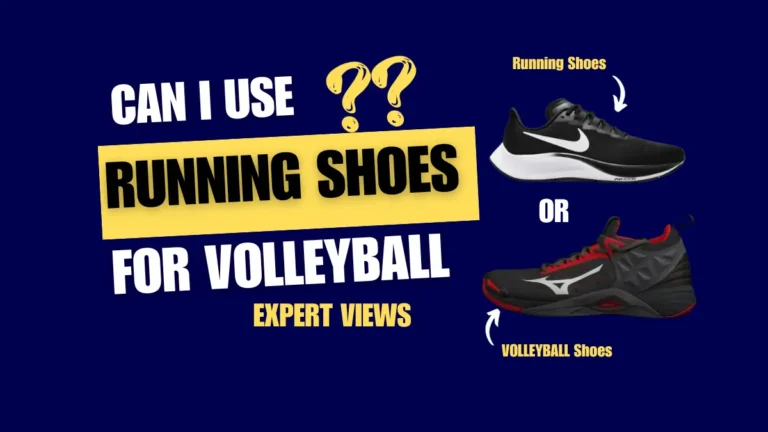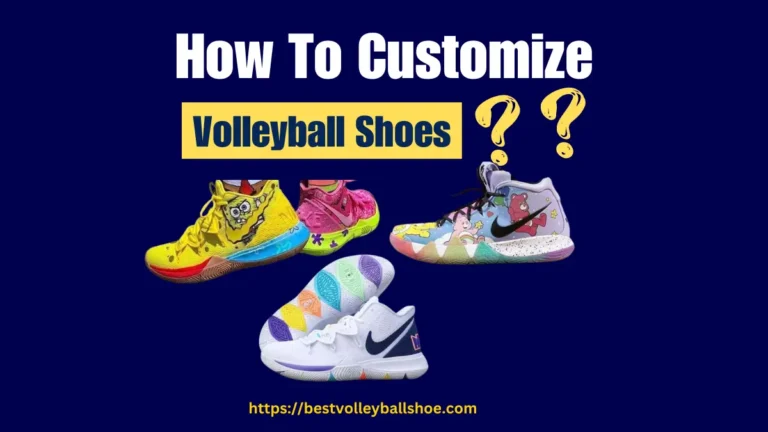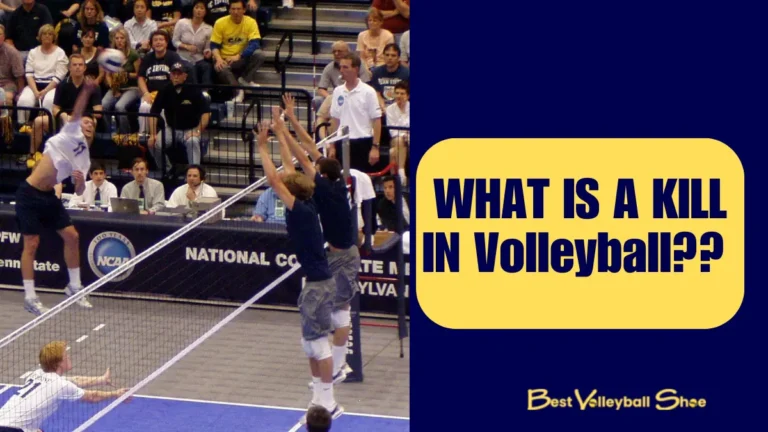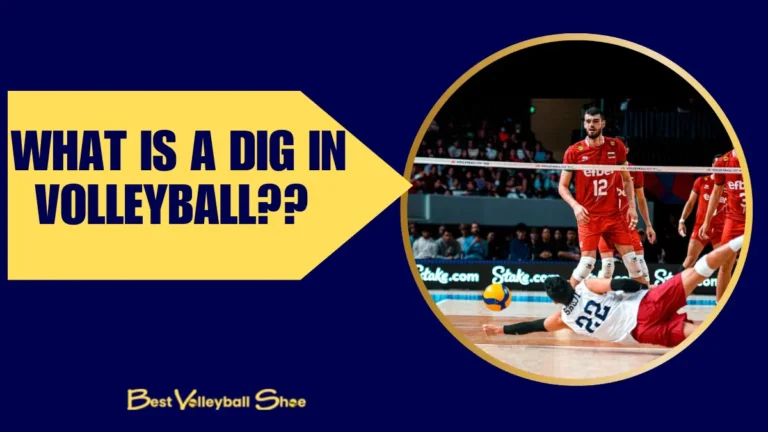Volleyball Court Dimensions
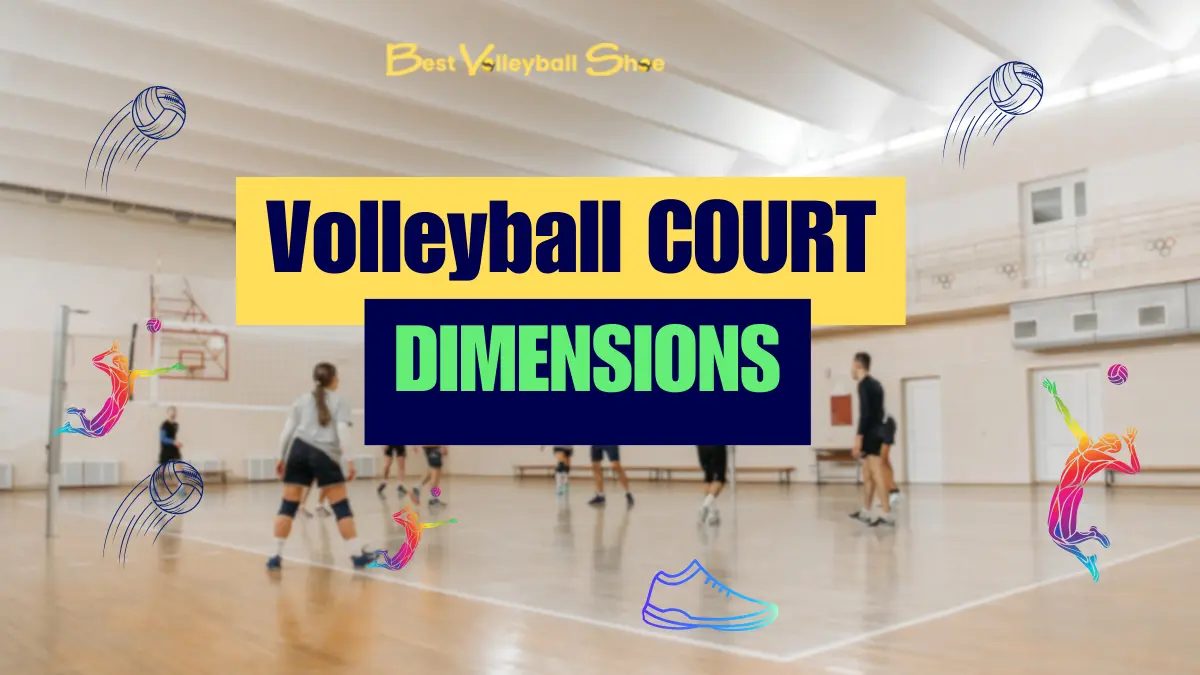
The size of the volleyball court affects the game and players’ performance by 110%, therefore it is of prime importance and given due consideration. The court dimension may vary from indoor gyms to under the direct sun –beaches.
Let’s dive deep into the volleyball court dimensions, what dimensions are perfect for what type of players or floors, including the sizes used around the world, in high schools, and on the beach.
This article covers everything you need to know about volleyball court sizes for different play levels and environments.
What Are the Dimensions of a Volleyball Court
Volleyball courts have almost the same dimensions for different categories and levels of play however, there are only a few exceptions like beach and youth volleyball.
Here’s a simple & straight away breakdown.
| Court Type | Width in Feet | Width in Meters | Length in Feet | Length in Meters |
| Indoor Volleyball | 29.5 feet | 9 meters | 59 feet | 18 meters |
| High School Volleyball | 29.5 feet | 9 meters | 59 feet | 18 meters |
| Women’s Volleyball | 29.5 feet | 9 meters | 59 feet | 18 meters |
| College Volleyball | 29.5 feet | 9 meters | 59 feet | 18 meters |
| Official Volleyball | 29.5 feet | 9 meters | 59 feet | 18 meters |
| Youth Volleyball | Varies | Varies | Varies | Varies |
| Beach Volleyball | 26.2 feet | 8 meters | 52.5 feet | 16 meters |
Why are there almost the same measurements for most courts?
As evident from the above table Indoor volleyball courts, regardless of age group or competitive level (high school, women’s, college, official), all courts except Youth and Beach, adhere to the standard size of 59 feet by 29.5 feet or 18 meters by 9 meters. The reasons of similarity in measurements are as under:-
The Anatomy of a Volleyball Court
The official volleyball court dimensions are crucial for players, coaches, and fans to fully grasp the game’s layout and rules. Official volleyball courts, both indoor and outdoor, share these dimensions:
The volleyball court is split into half by a centreline, with an attack line, a free zone around the court for player movement. Hence, a volleyball court’s design is not just about the outer lines but also the specific zones and markers that dictate the flow of the game.
Below is the detail of specific zones and components of the court :
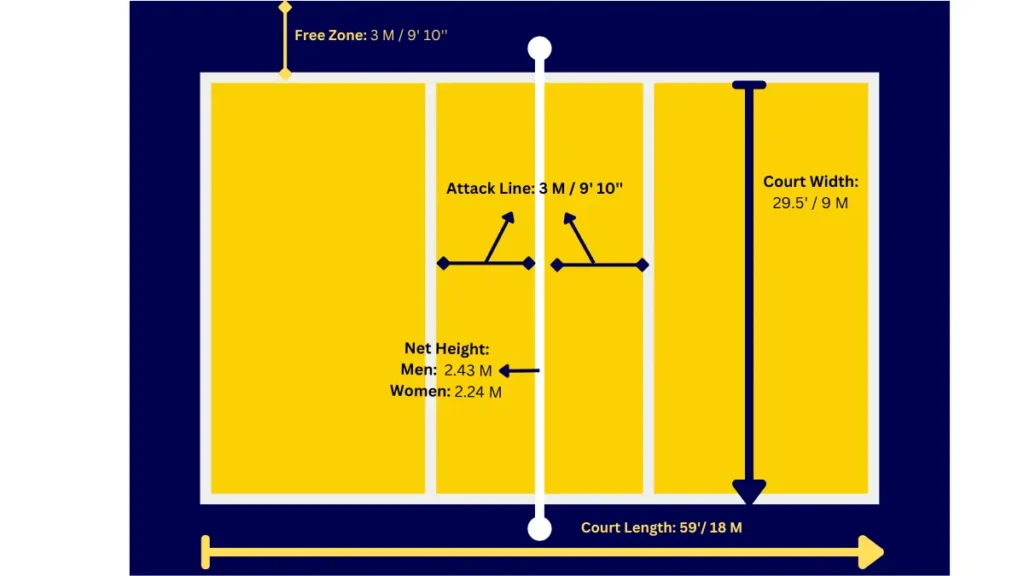
The Significance of the Attack Line Dimensions
The attack line, or ‘3-meter’ line, is located 9 feet 10 inches from the net. It separates the front-row players from the back-row players. The attack line plays a crucial role in defining the strategic possibilities within a volleyball game. Lemme tell you why this specific measurement is important:
| Purpose of the Attack Line | Benefits |
| Balancing Offense and Defense | Prevents dominance by powerful spikes, allowing fair defensive setups. |
| Promoting Strategic Setting | Encourages varied offensive plays beyond close-range attacks. |
| Enhancing Player Skills | Demands development of comprehensive volleyball skills for all players. |
Importance of Volleyball Court Dimensions
We’ll see how the different sizes change the way the game is played, from making plans with your team to how exciting the matches can be. Get set to learn lots about volleyball courts.
In the following table you’ll see a detailed overview of why these measurements are important:
| Aspect | Description | Impact on Game |
| Uniform Playing Field | Court size is consistent across all matches, providing equal space for both teams. | Ensures fairness, with victory determined by skill, not court size advantage. |
| Strategic Depth | The court’s length (18 meters) requires teams to balance offense and defense. | Demands strategic play setups, effective spiking, and coordinated movement to cover the court. |
| Athletic Demands | A width of 9 meters calls for player agility and quick reactions. | Players must quickly respond to ball trajectories, cover spaces, and execute defensive saves. |
| Safety Considerations | A surrounding free zone provides additional space, reducing collision risks. | Enhances player safety, allowing better ball anticipation and movement around the court edges without the risk of injury from collisions. |
Standardization & Evolution in Volleyball Courts
The volleyball court dimensions have been standardized to make it easy to adapt for players, in every part of the world. However, these standards have evolved. Here’s a quick summary of how it has evolved.
| Era | Event | Impact on Court Dimensions |
| Early 1895 | Invention of Volleyball | No fixed court size or net height, leading to diverse play styles. |
| 1912 | Initial Standardization | Moves towards standardizing court dimensions to favor longer rallies and strategic gameplay. |
| 1947 | Formation of FIVB | FIVB begins to oversee international play, including court dimensions, leading to more formalized standards. |
| Modern Times | Official Adoption of Dimensions | Court size set at 18m x 9m with a net height of 2.43m for men and 2.24m for women, balancing offensive and defensive play. |
| 1920s-1996 | Rise of Beach Volleyball | Beach volleyball courts set to 16m x 8m for the Olympics and professional play, accommodating the sand surface and 2-player teams. |
| Future | Potential Innovations | Any future changes to volleyball court dimensions will likely aim to enhance the sport for players and spectators, maintaining the strategic complexity and physical demands of the game. |
Volleyball’s journey from its creation to becoming a globally recognized sport involves significant changes in court dimensions as you can see in the table. Here’s a detailed overview of how these dimensions have transformed over time. So let’s start from the time when it was first invented.
1. Inception (1895)
William G. Morgan invented volleyball, initially called “Mintonette.” The game at that time, lacked standardized court dimensions and net height, which led people to play in a variety of play styles.
2. Early Standardization (1912)
Efforts to standardize volleyball court dimensions begin in 1912, to enhance the game’s strategic depth. It starts the evolution of game towards a more structured form of play, focusing on longer rallies and increased teamwork.
3. FIVB Formation and Global Standardization (1947)
The Fédération Internationale de Volleyball (FIVB) was established in 1947. FIVB introduced and enforced standardized court dimensions (18m x 9m) and net height (2.43m for men, 2.24m for women), to create consistency in international volleyball.
4. Advent of Beach Volleyball (1920s-1996)
Beach volleyball grew in popularity, which results in its Olympic debut in 1996. Beach volleyball adopts slightly smaller court dimensions (16m x 8m) to suit the 2-player team format and the challenging sand surface.
5. Modern Era and Ongoing Evolution
Volleyball continues to evolve, with potential future changes anticipated. While the core dimensions remain consistent, innovations in play, athlete training, and spectator experience may lead to further adjustments, to maintain the sport’s appeal and competitive balance.
In-depth Look Into Volleyball Court Measurements
Digging it deeper is important, because if you’re someone who wants to have it at your home or your gym, or you want to put up a volleyball setup on the beach, whatever it is, this in-depth analysis will help you to be at the perfection.
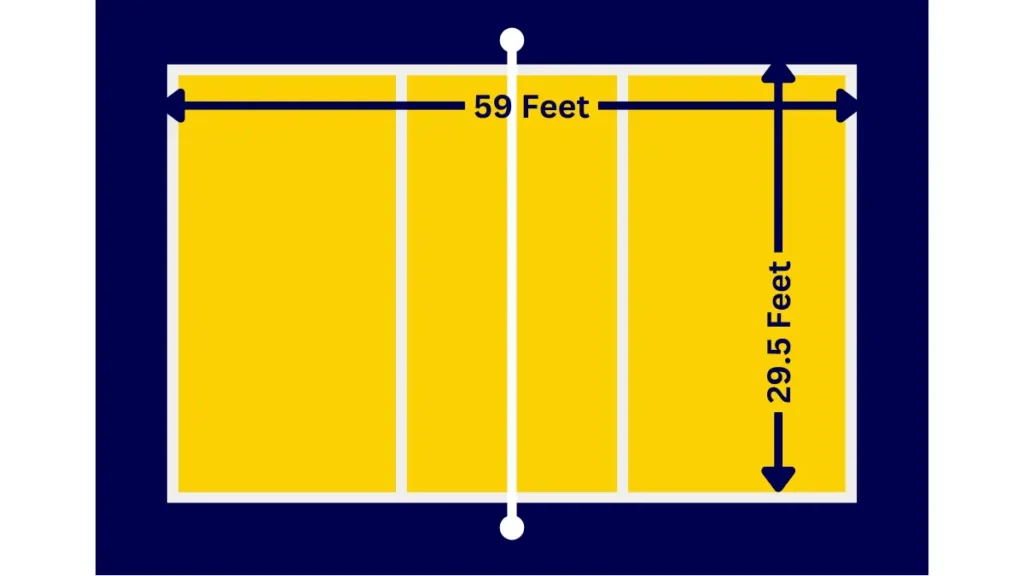
Volleyball Court Dimensions in Feet (Imperial Units)
Indoor and high school volleyball courts have these sizes:
Here’s why these sizes matter:
In the US, we use feet, but the world uses meters.
Volleyball Court Dimensions in Meters (Metric Units)
Around the world, and as per the FIVB (the big volleyball organization), courts are measured in meters:
Knowing these sizes is important for playing internationally. Here’s why meters are used worldwide:
Specialized Volleyball Court Dimensions
Most indoor volleyball games use the same size court, there are some special cases. Let’s look at high school volleyball courts and why they’re set up the way they are for young players.
High School Volleyball Court Dimensions
High school volleyball courts stick to the official size Length: 59 feet (18 meters), Width: 29.5 feet (9 meters) the same size as the big leagues but designed with young athletes in mind. This setup helps young players in a few ways:
However, sometimes the curt dimens=ions are amended to meet the needs of athletes in-process
College Volleyball Court Standards: NCAA Rules
The NCAA uses the same court size as the big international games:
Lemme tell you why this is good for college players:
| Benefit | Description |
| Getting Ready for Big Games | Helps players practice on the court size they’ll play on in pro or international levels. |
| Easy to Scout | High schools and colleges use the same court size, making it easier to scout and recruit players. |
| Worldwide Play | The court size matches international standards, including the Olympics, preparing players for global competitions. |
The NCAA also says there needs to be extra space around the court and specific net heights for men and women.
Professional & Olympic Volleyball Court Dimensions: FIVB Rules
The FIVB sets the court size for the world’s top volleyball games:
Why this standard matters:
| Reason | Impact |
| Fair Games Worldwide | Ensures every player competes on an equal playing field in international tournaments. |
| Easy Event Planning | Standard court sizes simplify organizing and hosting volleyball events globally. |
| No Surprises for Pros | Professional players can consistently prepare, knowing the court dimensions will be the same at all major tournaments. |
The FIVB also talks about where the attack line goes and what kind of floor is best for indoor courts.
Indoor vs. Beach Volleyball Courts
There’s a difference between the game play, indoors and outdoors, So comparison is crucial. Volleyball changes a lot depending on where you play it, either if it is inside or on the beach. Let’s look into the facts of what makes each place special.
Indoor Volleyball Court Dimensions
Indoor volleyball has a set size for the court, making the game fast and full of smart moves:
| Feature | Description |
| Length and Width | The court is 59 feet long and 29.5 feet wide. |
| Floor | Made of wood or synthetic materials for speed, safety, and ball control. |
| Free Zone | An extra space of about 9 feet 10 inches surrounds the court for play. |
| Ceiling Height | Minimum of 23 feet to prevent the ball from hitting the ceiling. |
Beach Volleyball Court Specifications
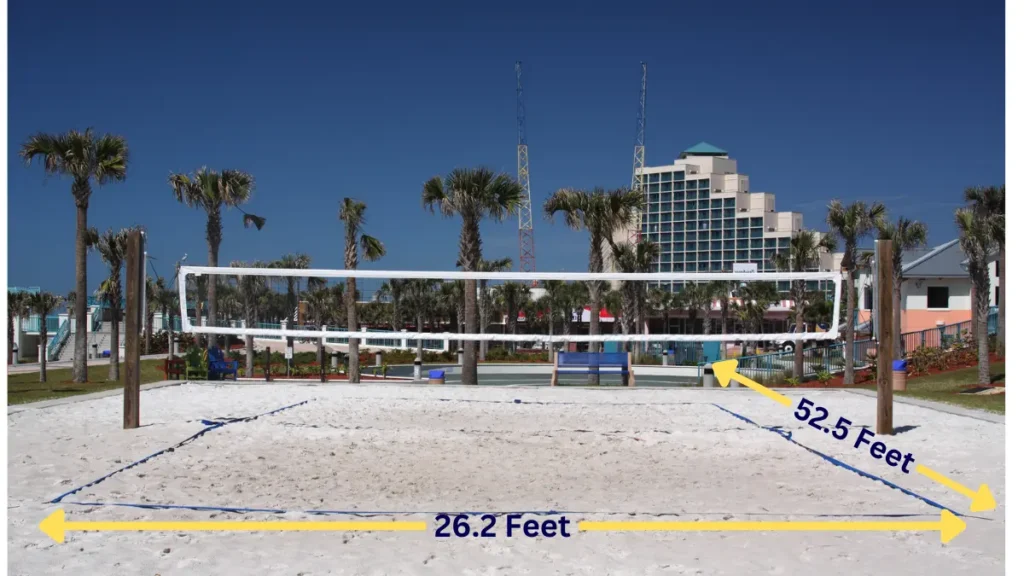
Beach volleyball is a bit different, making players work hard in the sand:
| Feature | Description |
| Length and Width | Court is 52.5 feet long and 26.2 feet wide. |
| Sand Depth | About 15.7 to 23.6 inches deep for soft landings and mobility. |
| Sand Type | Fine, well-maintained sand for consistent play. |
| Weather | Wind and rain add an extra challenge to each game. |
| Lines and Nets | Lines are marked in the sand; net posts can be easily moved. |
How to Customizing Volleyball Courts
Some DIY legends need to know how volleyball courts can be customized for different needs, from professional training to casual games. So we’re talking about how you can do that.
Adjustable Dimensions for Training and Practice
Adjusting court sizes can help players focus on specific skills, making practice sessions more effective.
Recreational vs. Official Volleyball Play
The difference between playing volleyball for fun and competitive matches affects court dimensions.
| Aspect | Recreational Play | Official Play |
| Court Size | Flexible, adjusted to fit the available space or preference. | Standardized (59 ft x 29.5 ft for indoor; 52.5 ft x 26.2 ft for beach). |
| Net Height | May be adjusted for ease of play or based on player height. | Fixed (7 ft 11.6 in for men; 7 ft 4.2 in for women indoor). |
| Rules | Can be modified for fun, number of players, or play style. | Strictly adhere to governing body regulations (FIVB, NCAA). |
| Objective | Focus on enjoyment, participation, and socializing. | Competitive, with emphasis on skill, strategy, and winning. |
| Equipment | May use improvised or less formal setups (portable nets). | Requires official volleyball equipment and court markings. |
Flexible Court Dimensions for Backyard and Community Play
For casual games, the strict rules on court size relax. Backyard and community games can adapt the dimensions to fit the available space, ensuring everyone can enjoy the game regardless of the setting. This flexibility makes volleyball more accessible and enjoyable for players of all levels.
How to Set Up a Volleyball Court
Setting up a volleyball court properly is essential for a fair and enjoyable game, whether it’s for professional matches or casual play in the backyard.
Equipment and Techniques for Court Setup
To set up a volleyball court, make sure that you have the necessary tools:
Tools
Techniques
Steps to Measuring and Laying Out Your Court
Conclusion
We’ve covered Volleyball court dimensions, standardized for pro-level play, flexibility for training, and backyard courts. Understanding these measurements, from net height variations to beach court specifics, makes it digestible for you to do it yourself without any guidance. Doesn’t matter if you’re a coach utilizing smaller courts for skill development or a player strategizing on a full-sized court, dimensions shape the game.
Frequently Asked Questions
Can I play volleyball on grass with beach volleyball rules?
Yes, you can play volleyball on grass using beach volleyball rules for a fun variation of the game.
How often should the net be replaced in a volleyball court?
It depends on usage and weather conditions, but checking the net for wear and tear annually is a good practice.
Are there different types of sand recommended for beach volleyball courts?
Yes, fine, washed sand that is debris-free is recommended for beach volleyball to ensure player safety and consistent play.
What is the best way to maintain an outdoor volleyball court?
Regularly leveling the playing surface, checking for debris, and ensuring the net and lines are in good condition are key maintenance steps.
Can volleyball court lines be made of materials other than chalk or paint?
Yes, court lines can also be made using ropes or flexible, durable tapes designed for sports courts.
Is it necessary to have boundary lights for an outdoor volleyball court?
While not necessary, boundary lights can enhance evening play by clearly defining court boundaries.
What are the key considerations when setting up a volleyball court indoors?
Ceiling height, floor material, and adequate space around the court for safety are crucial factors.
How do you adjust a volleyball net to the right height for different age groups?
Most nets have adjustable poles or mechanisms allowing you to change the net height according to the players’ age group and gender specifications.
Are portable volleyball systems a good option for casual play?
Yes, portable systems offer flexibility for setting up a court in various locations and are ideal for casual or recreational play.
What’s the recommended way to store volleyball equipment when not in use?
Store nets, balls, and other equipment in a dry, cool place away from direct sunlight to prevent damage and extend their life.
